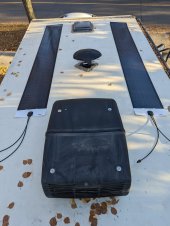Hi, just wondering about why CIGS panels haven't really taken off for RV use in particular.
I've seen that with many discussions of CIGS flexible solar panels that folks seem to get them conflated with some of the drawbacks of flexible crystalline panels, focusing on the 'flexible solar panel' part; namely that they're fragile and have low yield efficiency - but not necessarily...
CIGS seem to be:
* Durable - not prone to microcracking, cells are robust to the point of puncturing. Seems better suited to the 'rolling earthquake' of an RV roof.
* Efficient - while overall efficiency may be less than crystalline, they're more effective in the
shade (one
company even
advertises that
each cell has a bypass diode so you really only lose the power of the one shaded cell, not the whole string) - a trade-off that seems better for RV/vehicle use
* Better at handling high temperature power losses
* Better at utilizing a wider spectrum of light - more power production during overcast days and low sun angles
* Have warranties comparable to rigid crystalline panels
I've heard
@Will Prowse mention them in passing in a video, I'd love to get a more in-depth analysis though - for my RV I've been hesitant to get flexible panels due to the drawbacks others have mentioned, and can't seem to commit to heavy rigid panels that will need to be drilled to my TPO roof, and may not do as well in shaded/overcast environments. The CIGS flexible panels seem to be the goldilocks solution...am I missing something?



